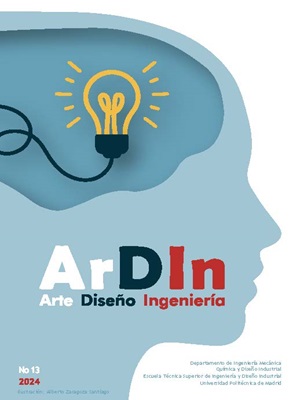Unraveling Design Principles from Buchanan’s thinking = Desentrañando los principios de diseño del pensamiento de Buchanan
DOI:
https://doi.org/10.20868/ardin.2024.13.5216Keywords:
Design Principles, Buchanan’s Thinking, philosophy, Four Orders, Principios del Diseño, Pensamiento de Buchanan, Filosofía, Cuatro ÓrdenesAbstract
Producing new knowledge and training design professionals are constant concerns in Buchanan's discourse. The author seeks to provoke debate, motivate reflection, and identify gaps in both contexts. Therefore, he proposes to rethink the design disciplines and to reconstruct them. This article introduces Buchanan's ideas, first, around the development of new knowledge, followed by a review and discussion of his "four orders"; then, it proposesto interpret these same orders as principles, given that, from the point of view of this research, it might be more nourishing for the construction of knowledge to rethink Buchanan's concepts as principles instead of orders: the symbolic, material, action, and systems principle. Moreover, instead of four, a fifth principle based on the author's concepts is conceived: the transition principle, which takes his ideas from a transitional perspective. In this article, I propose five principles to trigger reflection and thinking, develop new knowledge in design, and question the structures through which we train design professionals, intentions faithfully rooted in Buchanan's thinking.
Resumen
Producir nuevos conocimientos y formar profesionales del diseño son preocupaciones constantes en el discurso de Buchanan. El autor siempre busca suscitar el debate, motivar la reflexión, e identificar lagunas en ambos contextos. Por ello, propone repensar las disciplinas del diseño y reconstruirlas. Este artículo introduce las ideas de Buchanan, primero, en torno al desarrollo de nuevos conocimientos, seguido de una revisión y discusión de sus “cuatro órdenes”; después, se propone interpretar estos mismos órdenes como principios, dado que, desde el punto de vista de esta investigación, podría ser más nutritivo para la construcción del conocimiento repensar los conceptos de Buchanan como principios en lugar de órdenes: el principio simbólico, material, de acción y de sistemas. Además, en lugar de cuatro, se propone un quinto principio basado en los conceptos del autor: el principio de transición, que contempla sus ideas desde una perspectiva transicional. En este artículo, propongo cinco principios para desencadenar la reflexión y el pensamiento, con el objetivo de contribuir al desarrollo de nuevos conocimientos en diseño y cuestionar las estructuras a través de las cuales formamos a los profesionales del diseño, intenciones fielmente arraigadas al pensamiento de Buchanan.
Downloads
References
Bauman, Z. (2003). Modernidad Líquida. Fondo de Cultura Económica.
Buchanan, R. (1992). Wicked Problems in Design Thinking. Design Issues, 8(2), 5-21.
Buchanan, R. (1998). Education and professional practice in design. Design Issues, 14(2), 63 – 66.
Buchanan, R. (2001). Design Research and the New Learning. Design Issues, 17(4), 3–23.
Buchanan, R. (2001b). The Problem of Character in Design Education: Liberal Arts and Professional Specialization. International Journal of Technology and Design Education, 11, 13–26.
Buchanan R. (2001c). Children of the Moving Present: The Ecology of Culture and the Search for Causes in Design. Design Issues, 17(1), 67-84. https://doi.org/10.1162/07479360152103840
Buchanan, R. (2008). Introduction: Design and Organizational Change. Design Issues, 24(1), 2–9.
Buchanan, R. (2019). Surroundings and Evironments in Fourth Order Design. Design Issues 35(1), 4-22.
Capra, F. (1999). Ecoliteracy is the challenge for education in the next century. Center for Ecoliteracy.
Cross, N. (1982). Designerly ways of knowing. Design Studies, 3(4), 221-227.
Findeli, A. (2001). Rethinking Design Education for the 21st Century: Theoretical, Methodological, and Ethical Discussion. Design Issues, 17(1), 5-17.
Irwin, T. (2015). Transition Design: A Proposal for a New Area of Design Practice, Study, and Research. Design and Culture, 7(2), 229-246.
Lee, Y. (2008). Design participation tactics: the challenges and new roles for designers in the co-design process. CoDesign, 4(1), 31-50.
Lopez-Leon, R. (2017). Aspectos contextuales en la formación de diseñadores: comrender el taller de diseño. ArDIn. Arte, Diseño e Ingeniería, 6, 46-62.
Manzini, E. & Rizzo, F. (2011). Small projects/large changes: Participatory design as an open participated process. CoDesign, 7(3-4), 199-215.
Morin, E. & Le Moigne, J.L. (2000). A inteligência da complexidade. Petrópolis.
Norman, D. (2013). The Design of Everyday Things. Basic Books.
Ortega y Gasset, J. (1985). La barbarie del especialismo. La rebelión de las masas. https://filosofiauacm.files.wordpress.com/2010/02/jose_ortega_y_gasset_-_la_rebelion_de_las_masas.pdf
Oxford. (n.d.). Principle. In Lexico. Retrieved October 2, 2019, from https://www.lexico.com/en/definition/principle.
RSD6 (2017). RSD6 - Keynote - Richard Buchanan. [video]. Vimeo. https://vimeo.com/246275548
RSD6 (2017b). RSD6 - Plenary Lecture - Kees Dorst. [video]. Vimeo. https://vimeo.com/246277677
Schön, D. (1987). Educating the reflective practitioner: Toward a new design for teaching and learning in the profession. Jossey-Bass.
Simon H. (1969). Science of the artificial. MIT PRESS.
Design Council, The. (2007). Eleven lessons: managing design in eleven global brands. A study of the design process. The Design Council. https://www.designcouncil.org.uk/resources/report/11-lessons-managing-design-global-brands
Tooming Buchanan, K. (2022). Issue Mapping Strategy: Process of Discovery, Places of Invention and Design Process Fallacies. Design Issues 38(4), 3–20.
Downloads
Published
Issue
Section
License
ArDIn does not charge authors for processing or publishing an article and provides immediate Open Access to its content. All content is available free to the user or their institution. Users are permitted to read, download, copy, distribute, print, search or link to the full text of articles, or use them for any other lawful purpose, without prior permission from the publisher or author. This is in accordance with the BOAI definition of open access.
- Authors retain the copyright and grant to the journal the right to a Creative Commons attribution / Non-Commercial / Non-Derivative 4.0 International (CC BY NC ND) License that allows others to share the work with an acknowledgement of authorship and non-commercial use.
- Authors may separately establish additional agreements for the non-exclusive distribution of the version of the work published in the journal (for example, placing it in an institutional repository or publishing it in a book).
Unless otherwise indicated, all contents of the electronic edition are distributed under a Creative Commons license.













